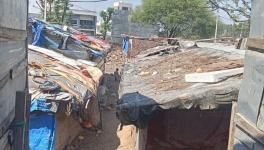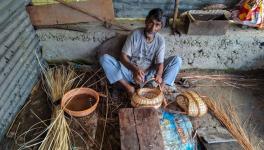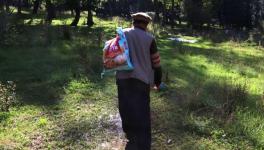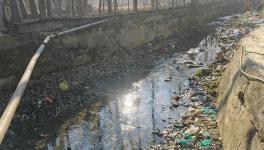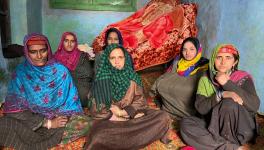Kashmir Witnesses a Shift in Militancy at the End of a Decade
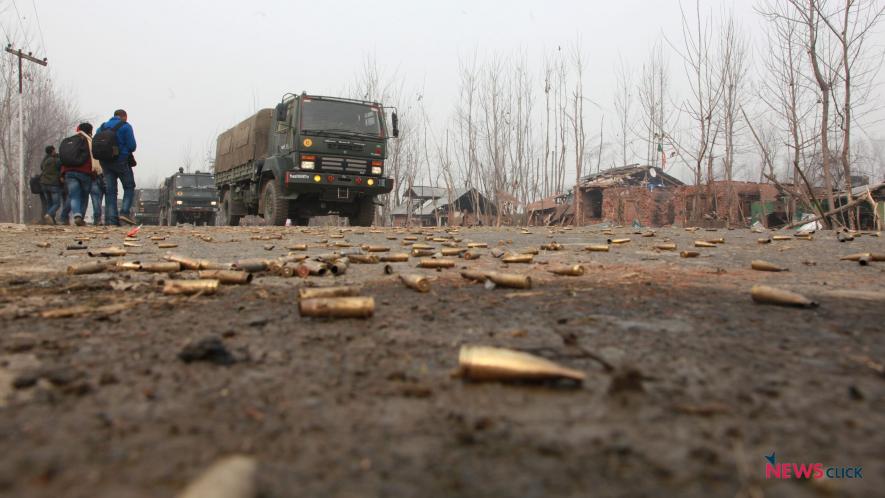
Image Credit: Kamran Yousuf
Srinagar: A new militant outfit Lashkar e Mustafa (LeM) has surfaced in South Kashmir’s Shopian and Pulwama, a former stronghold of Hizbul Mujahideen, as 2020 nears its end with over 200 militants killed in one year—a majority of them being local recruits.
These new recruits from South Kashmir, according to sources in the security forces, are being led by a resident of Shopian, Hidayatullah Malik who has been successful in recruiting local residents into his ranks. “There are about a dozen LeM militants active in South Kashmir and most of them have been recruited in tge past three months,” a security official told NewsClick.
The outfit’s leader Hidayatullah, who officials believe is in his 20s, leads a LeM group that he refers to as “Hasnain Army” based on his own codename – Hasnain. His pictures brandishing weapons have also surfaced on social media networks like Facebook.
The outfit, which is suspected to be involved in looting over Rs 60 lakh from a cash van in Shopian area in November, however, is reportedly “hostile” to foreign militants, mostly of Pakistani origin. “They are attempting to thwart the influence of foreign groups like Lashkar e Toiba and especially Jaish which is trying to gain its footing in the areas,” the security official added.
Two militants, however, belonging to Al Badr outfit – both locals of South Kashmir - suspected to have been involved in the robbery case, according to police, were killed on November 10.
LeM is not the only new militant outfit to have appeared in Kashmir this year. Multiple outfits have surfaced in the region amongst which The Resistance Front (TRF) and People’s Anti-Fascist Front (PAFF) have gained prominence. The two groups have by their own admission carried out several attacks in the region. The TRF is seen as an arm of the Tehreek ul Mujahideen (TuM) and LeT but, the J&K police officials have so far termed their influence as “limited within the cyber space.”
Hizb losing influence
In the past decade, insurgency in Kashmir has witnessed a revival with local recruits aided by foreigners carrying out major attacks and spectacular symbolism with the use of social media. As the decade ends, security officials are suspecting another shift in militancy with local recruits and foreigners parting their ways as outfits like Jaish are attempting to gain ground.
Amid this shift, however, the Hizbul Mujahideen, the frontrunner of militant resurgence in the Valley, seems to be caught. Its ranks are dwindling and influence waning due to the continuous offensive from the government forces throughout the year 2020.
Also read: Kashmir: Hizbul Mujahideen Top Commander Riyaz Naikoo Killed
After the killing of two successive top commanders of Hizb – Naikoo and his successor Dr Saifullah – the outfit has named Zubair Wani, a resident of Anantnag as its new chief. “This has happened for the first time in the decade that the leadership has moved beyond its stronghold of Pulwama and then Shopian,” an army official told NewsClick.
While there have been close to 150 recruitments in militant ranks this year, the security officials believe that the influence of Hizb has decreased significantly as new outfits emerge. “This year, especially in the past six months, the recruitment in Hizb has fallen drastically. There have been almost negligible recruitments in their ranks,” a security official said.
The militants in the Valley are facing a dearth of weapons and several of the youth caught by government forces had not even received basic arms training, the official said. “If the dearth continues and the supply chain is broken repeatedly it is difficult for the local militants to survive which is why there have been many surrenders this year, that too from the encounter sites,” he added.
Even as the local recruitments have witnessed a rise, so have the counter-insurgency operations and militant killings. As part of it plans to eliminate militancy, the government launched a major offensive called the “Operation All-Out” in 2017.
While in the first half of the decade, as many as 530 militants were killed, in the next half since 2016, over a 1,000 militants have been killed, a majority of them in 2018, according to official figures.
The killing of Hizb’s most wanted militant Riyaz Naikoo, considered by many as one of the most lethal commanders of the decade, this year in May, dealt a strong blow to the outfit whose network had already suffered its first blow due to the arrest of another militant Naveed Babu alongwith a decorated J&K police officer Davinder Singh in January.
Also see: Kashmir - A Year After the Abrogation of Article 370
Following the Narendra Modi-led NDA government’s unilateral decision to abrogate Article 370 in Jammu and Kashmir to revoke its “special status”, a massive crackdown was imposed in the region to obstruct attempts of opposition on August 5 last year. Ahead of the move, additional 38,000 troops were called for deployment in the region to restrict movement. All communication services including mobile, landline and internet services were snapped which continued for months.
While the crackdown did not impact the militant activities, the counter-insurgency operations were halted until the communication services were restored. The abrogation move was followed by attacks on non-local Kashmiris in which close to dozen workers and traders were killed, suspected to have been carried out by Naveed Babu.
The changing landscape
Meanwhile, in the summer capital of Srinagar, where least militant recruitments have been reported in the past decade as compared to the rural north and southern parts of the Valley, as many as nine encounters have broken out between militants and government forces this year alone, indicating a sudden rise of militant activities. Two of the top Hizb commanders including a Hurriyat leader’s son Junaid Sehrai and Dr Saifullah were also killed in the city.
“As of now there are at least three militants currently active from Srinagar which shows a shift in the situation. Not that the area was free of militancy earlier, but this indicates that attempts are being made to spark the urban centre,” the security official told NewsClick.
In the northern part of the Valley, the number of foreign militants has been two to three times higher than the local residents, while the rural south has been mostly dominated by local recruits to militant outfits until now, according to officials in the security grid. “Their numbers are increasing, especially from the Jaish which has over 20 actives including some presence in Pulwama,” another official said.
Even as the local militants are facing lack of arms and ammunition, there have been attempts to arm them through unmanned aerial vehicles (UAVs), which is a “new pattern”. In June this year, the Border Security Force (BSF) claimed it shot down a Pakistani drone carrying a payload of arms including US-made M4 carbine and seven Chinese grenades in Jammu’s Kathua district.
Also read: Kashmir Insurgency: The Rise and Decline of Militant South
The border areas in Jammu from the past year are being used by the militant outfits like Jaish and LeT for infiltration while the traditional routes along the Line of Control (LoC) are mostly being used to pump narcotics and ammunition albeit insubstantially, according to officials privy to the developments.
What has, however, increased concerns in the security grid is the rise in the ceasefire violations (CFV) along the Line of Control (LoC), especially post the abrogation of Article 370. The tension in the borders as heightened due to dozens of civilian casualties on both sides since the government imposition last year’s move.
One of the worst CFVs was reported earlier on November 13 in which as many as 11 casualties were reported including six civilians. “Now, even a small provocation on the either side causes a major flare-up on the entire LoC,” a security official explained.
Decade of turmoil
Militancy in Kashmir was at its lowest ebb in the beginning of last decade since the armed insurgency broke out in the region in year 1989. The last decade saw militant ranks in all insurgent groups, which emerged in the 1990s, take a fall. The cadres of major outfits had shrunk significantly with a little over 100 militants active in 2011, the lowest by then.
Outfits like Harkat-ul-Mujahideen (HuM), Tehreek-ul-Mujahideen (TuM), Al-Jehad and Al-Badr had lost the ground almost entirely and were never able to revive themselves since then except in few numbers. Amid this decline, the Hizb ranks remained intact with recycled militants and new young recruits across Kashmir Valley. The outfit led by Pakistan-based Syed Salahuddin – also the head of United Jehad Council (UJC) - had survived the turf-war in the early 1990s and counter-insurgency operations later, a time when the first militant uprising began to wither.
In 2013, the number of militants active in the region fell even below 100, the lowest in the three decades old insurgency history of Kashmir so far. By then, designated terror outfits like Lashkar-e-Toiba (LeT) and Jaish-e-Mohammad (JeM) with mostly foreign cadres, had also been pushed into the shadows. During this time, South Kashmir’s Tral and Sopore in the north emerged as militant hotspots.
After the hanging of the 2001 Parliament attack convict Afzal Guru in 2013, Jaish was able to revive itself from across the Line of Control (LoC) by creating “Afzal Guru Squad” that went on to carry out major attacks in the years that followed. Meanwhile, inside Kashmir, the militant ranks began to grow again gradually with LeT’s militant Abu Qasim, of Pakistani origin, at the steering wheel.
Also read: Kashmir: In Face of Back to Back Operations Against Militants, Situation Remains ‘Volatile’
According to security officials, Qasim was active across Kashmir and mobilised cadre that paved way for the renewed insurgency. Before Qasim was killed in 2015, he was involved in major attacks in Srinagar’s Hyderpora, Jammu’s Udhampur and assassinated a top counter-insurgency cop of the J&K police Altaf Ahmad aka “Laptop.” Qasim’s funeral, which was attended by thousands of local residents, was the first indication of militant escalation in the decade.
Around the same time, the reins of Hizb fell into the hands of Burhan Wani, who used social media as a tool to personify militancy in Kashmir. The narrative around teenage militant Wani, who had picked up arms after facing “humiliation by government forces provided impetus to youth who were anguished by successive summers of turmoil between 2008 and 2010, during which over 400 civilians were killed, thousands injured and many others detained”, according to the security official.
The ranks, however, swelled with increase in incidents of snatching weapons from the security forces personnel. In 2015, as Wani posted a picture presumably taken in Shopian of a group of a dozen militants, insurgency had entered “the new-age” with South Kashmir areas of Pulwama, Tral, Kulgam and Shopian as strongholds. In North Kashmir, it had started to deplete due to infighting within Hizb ranks after a top commander Qayoom Najar formed a breakaway faction Lashkar e Islam (LeI).
While Qasim mobilised the ranks, Wani emerged as the face of the resurgence and his killing in July 2016 became a catalyst for a sharp increase in militant recruitment.
“Burhan’s use of social media and his death resulted in an increase in the recruitment. The agitation that followed his death was also used for increasing base and attracting more recruits,” an army official told NewsClick.
While Hizb was dealing with the infighting in Sopore and Burhan craftily using social media to build an image and annoy the security grid, on the ground, a recycled militant commander Yaseen Yattoo and another Riyaz Naikoo were busy recruiting, he added. From six reported recruitments in 2013, the numbers had risen to 88 in 2016, 139 in 2017 and 191 in 2018, highest in the decade. Most of the these recruitments were carried out by the Hizb outfit. But, with the group losing influence, the territory seems to be open to new players and outfits.
Also read: Death, Injury, and Trauma: Life of Children in Conflict
Disclaimer: 5th Paragraph was added later in the copy.
Get the latest reports & analysis with people's perspective on Protests, movements & deep analytical videos, discussions of the current affairs in your Telegram app. Subscribe to NewsClick's Telegram channel & get Real-Time updates on stories, as they get published on our website.









